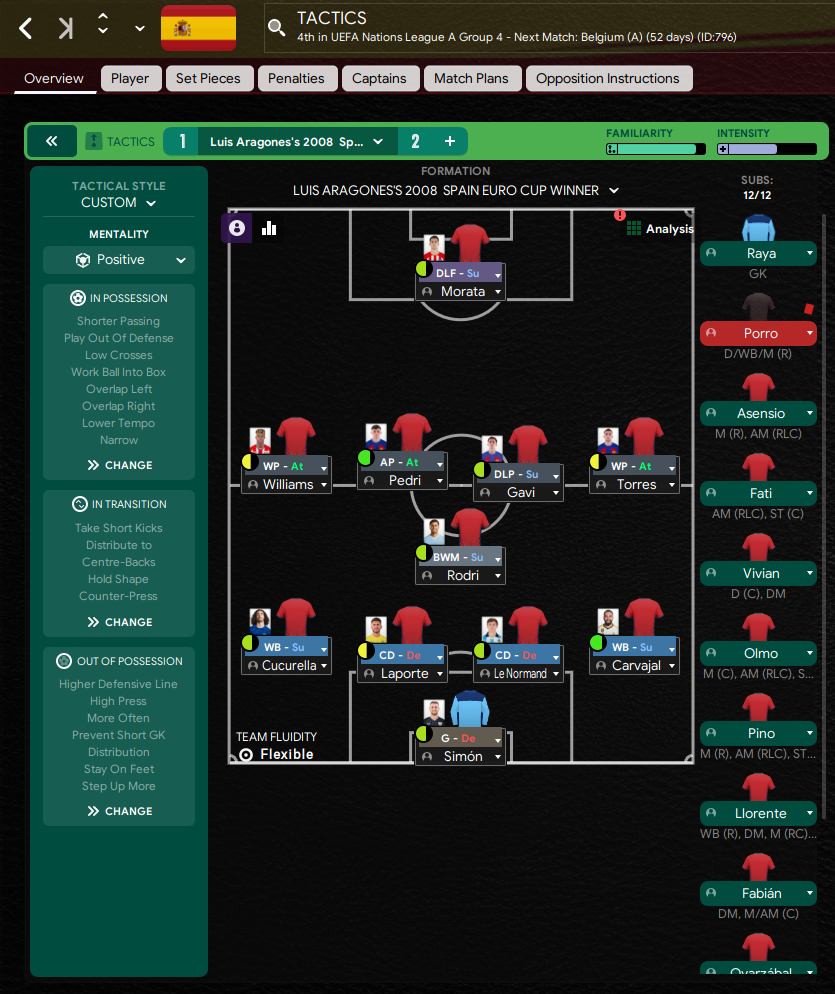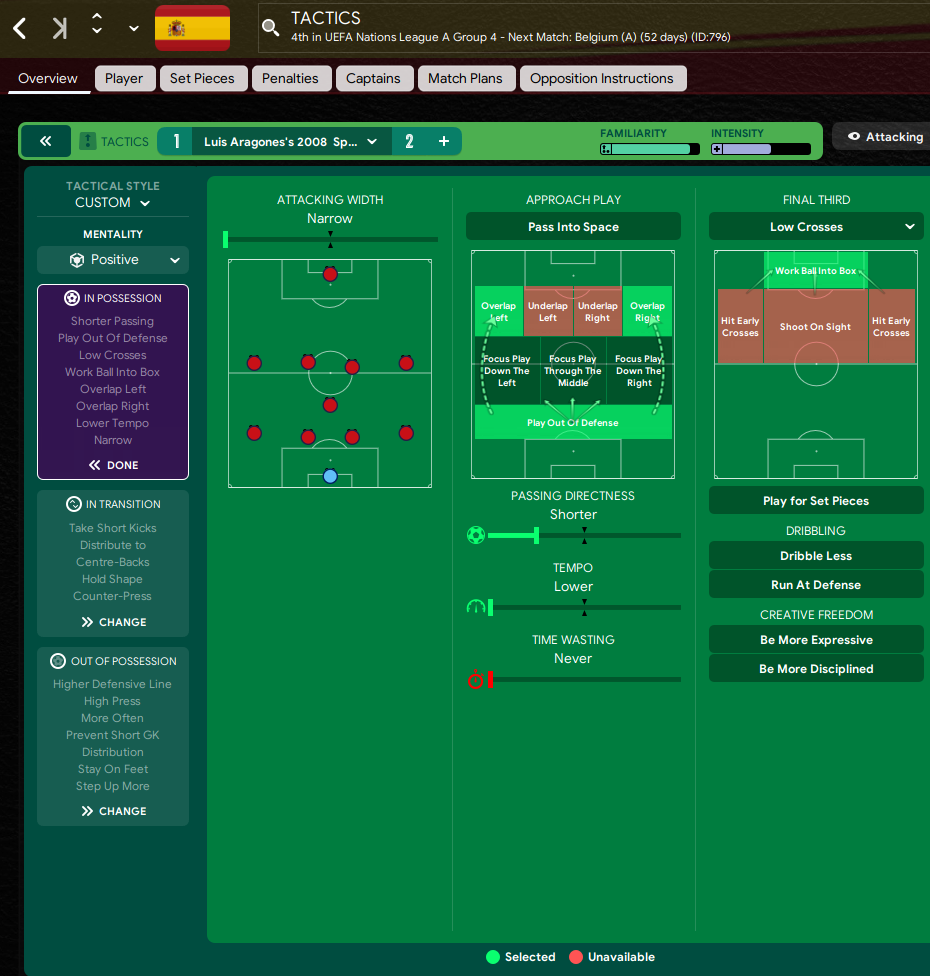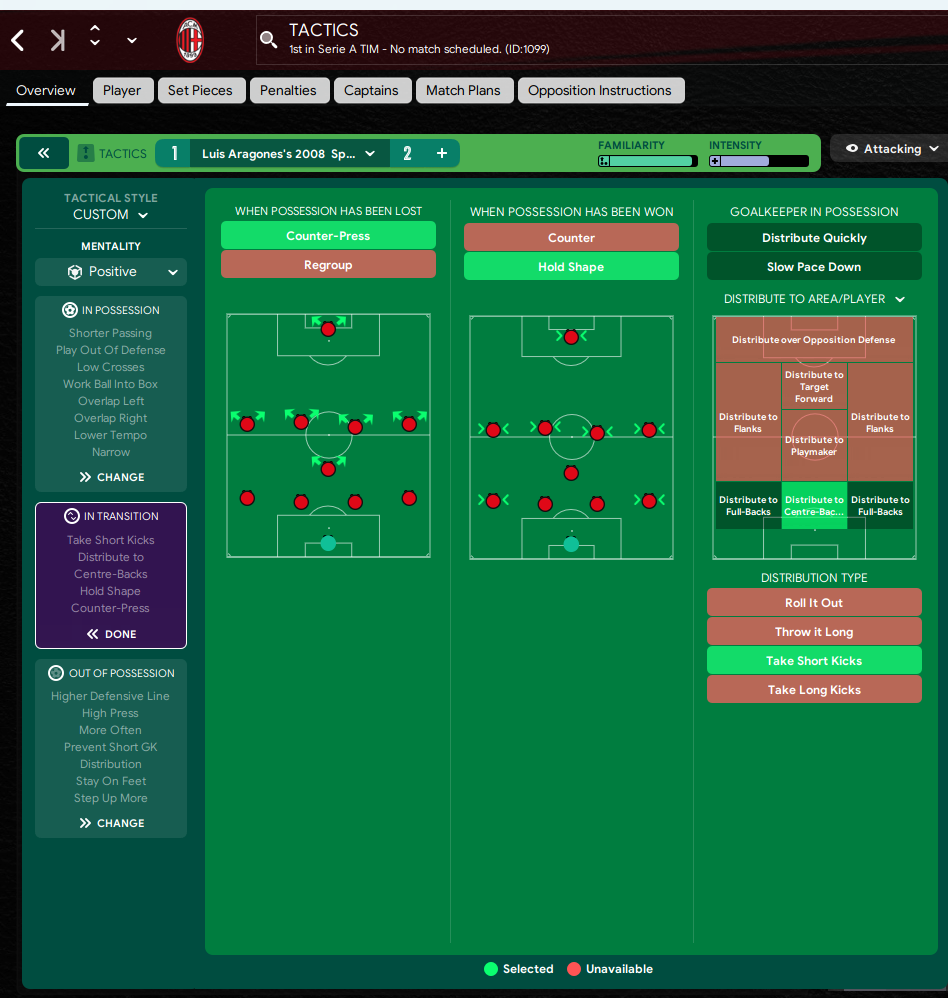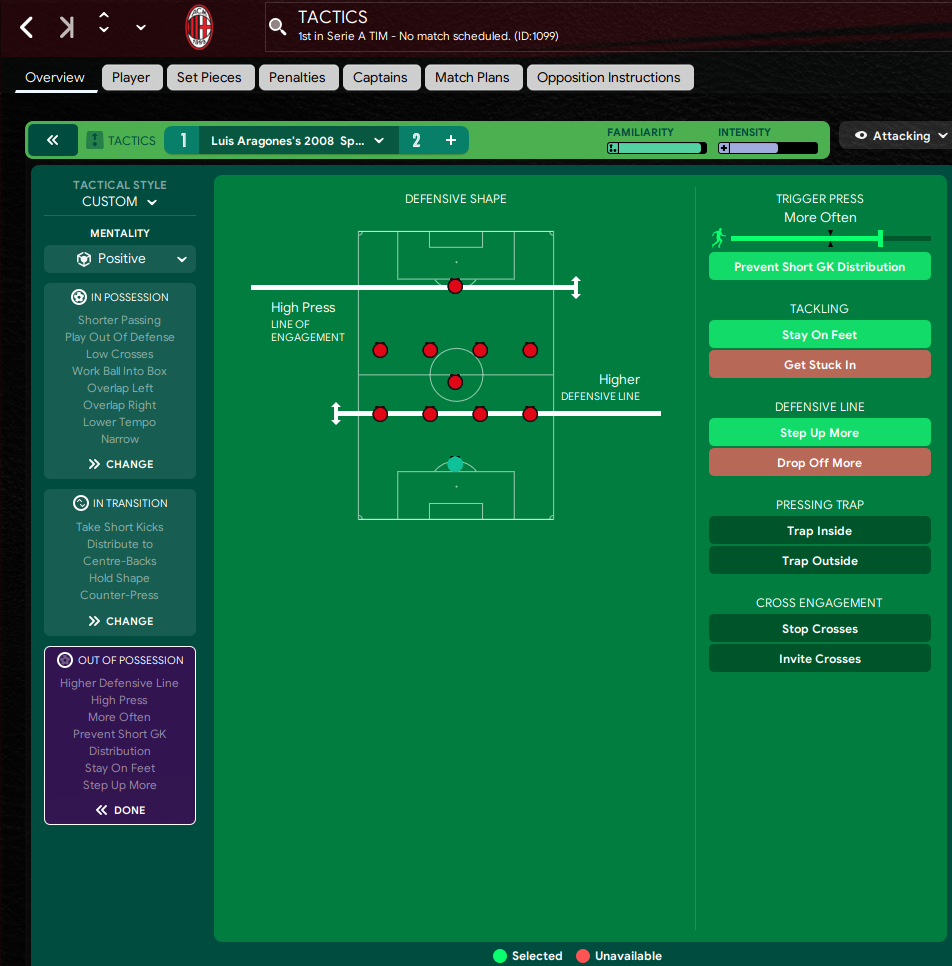Data Update Poll!
Hello, there is currently an important debate going on regarding how to manage the FM24 Data Update going forward, particularly in the case of modifying the ages and contract dates by 1 year. Please can you vote in the poll and join in the discussion.
| Tester | Team | ME | Win % | PPG | AGF | AGA | GD | PL | W | D | L | |
|---|---|---|---|---|---|---|---|---|---|---|---|---|
| Total | 85% | 2.67 | 3.43 | 0.76 | 2.67 | 54 | 46 | 6 | 2 | |||
| Deleted User #1866315 |
 Spain
Spain
|
24.3.0 | 88% | 2.69 | 3.7 | 0.9 | 2.81 | 16 | 14 | 1 | 1 | |
| Deleted User #1866315 |
 Milan
Milan
|
24.3.0 | 84% | 2.66 | 3.3 | 0.7 | 2.61 | 38 | 32 | 5 | 1 | |
LUIS ARAGONES’S SPAIN 2008
Tactical Analysis of Spain's 2008 European Championship Triumph under Luis Aragonés
Spain's triumph at the 2008 European Championship marked a pivotal moment in football history, as it signaled the rise of a new era dominated by a distinct style of play characterized by quick, short passes, and a strong emphasis on ball possession. Under the guidance of Luis Aragonés, Spain showcased a fluid and dynamic 4-3-3 formation that revolutionized modern football.
Formation and Structure
Spain’s 4-4-1-1 formation under Aragonés was designed to maximize ball control and fluidity. The defensive line was composed of a solid back four, with Sergio Ramos and Joan Capdevila as the full-backs, providing width and attacking support. The central defense was anchored by the experienced duo of Carles Puyol and Carlos Marchena.
The midfield trio, often regarded as the heartbeat of the team, included the deep-lying playmaker Xavi Hernández, who orchestrated the play from a central position. Alongside him, Marcos Senna provided a defensive shield with his combative presence, while Andrés Iniesta’s creativity and dribbling ability offered an additional attacking dimension.
In attack, David Villa was a decoy forward, cutting inside to exploit spaces, while the central striker role (Fernando Torres) was fluid, with Torres dropping down and exchanging positions with other attacking players. This flexibility allowed for a seamless interchange of positions, confusing defenders and creating numerous goal-scoring opportunities. On the other side, David Silva also exploited spaces cutting inside, so Xavi had always two choices when he received the ball, pass to Silva or Villa (in the final match against Germany, Villa was injured and replaced by Fabregas who played central in the midfield while Iniesta took Villa’s role on the left side.
Key Tactical Elements
- Possession-Based Play: Spain's emphasis on maintaining possession was central to their strategy. The team’s high pass accuracy and patient buildup play aimed to wear down opponents and create openings.
- High Pressing: Aragonés implemented a high-pressing game, where the team sought to regain possession quickly after losing it. This intense pressing disrupted the opposition’s play and allowed Spain to dominate territorial control.
- Fluid Movement and Positional Interchange: The front three’s fluid movement and the midfield’s ability to interchange positions were crucial. This movement created unpredictability and stretched the opposition’s defensive lines.
- Compact Defense: Despite their offensive prowess, Spain’s defense remained compact and organized. The back four, shielded by Senna, maintained a high line to compress the space and facilitate quick transitions from defense to attack.
- Exploiting Width: Full-backs Ramos and Capdevila provided additional width, overlapping with the wingers and delivering crosses into the box. This width stretched the defense, creating space for the midfield and forwards to exploit because the opponent had to choose between pressing the central midfielders or the two full-backs.
Critical Matches and Performances
- Semi-Final vs. Russia: Spain’s 3-0 victory showcased their dominance in possession, with Xavi and Iniesta dictating the tempo and David Villa’s clinical finishing.
- Final vs. Germany: The 1-0 win highlighted Spain’s defensive solidity and tactical discipline. Fernando Torres’ decisive goal came from exploiting space behind the German defense, a testament to Spain’s strategic planning and execution.
Recreating Spain’s 2008 4-3-3 Tactics in Football Manager 2024
Formation Setup
Formation: a 4-1-4-1 formation with two central defenders, two full-backs, one defensive midfielder, two central midfielders, two wide midfielders (who act as wingers) and one striker.
Player Roles and Instructions
Goalkeeper: Goalkeeper (Defend), Pass it shorter.
Full-Backs (Left and Right): wing-Back (Support) – Encourage overlapping runs and provide width in attack.
Central Defenders: Central Defender (Defend) – Close down more, mark tighter, take fewer risk, pass it shorter
Defensive Midfielder: Ball Winning Midfielder (Support) – Protect the defense and recycle possession. Marcos Senna’s role. Mark tighter, hold position
Central Midfielders:
Deep-Lying Playmaker (Support) – Xavi’s role, orchestrating play from deep. Pass it shorter.
Advanced Playmaker (Attack) – Iniesta’s role, driving forward and creating chances. Pass it shorter, roam from position, get further forward
Wide midfielders:
Wide Playmakers (Attack) – David Villa’s and David Silva, cutting inside and creating goal-scoring opportunities. Get further forward, pass it shorter.
Striker: Deep-Lying Forward (Support/Attack) – Flexible role to interchange with wingers, linking up play and finishing chances. Dribble less.
Team Instructions
Mentality: Positive – Emphasize maintaining possession and controlling the tempo.
In Possession:
Shorter Passing
Lower Tempo
Narrow Attacking Width
Play Out of Defence
Work Ball into Box
Overlap Left/Right
Low crosses
In Transition:
Counter-Press
Hold Shape when possession is lost to regroup quickly.
Distribute to center backs and take short kicks.
Out of Possession:
Higher Defensive Line
Higher Line of Engagement
More Often Trigger Press
Step Up More
Stay on Feet
Prevent Short GK Distribution
Test Results
 Milan
Milan
 Spain
Spain
You'll need to Login to comment





